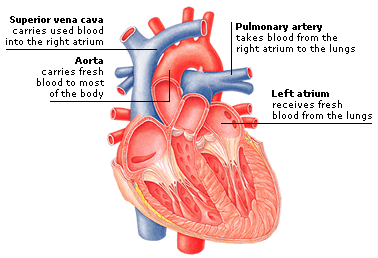DK Human Body: Heart
Blood is driven around the body by the heart, a powerful muscular pump that never stops beating. The heart is a dual pump. The left side sends blood to the body, while the right sends blood only to the lungs.
There are four chambers in the heart: two on the left and two on the right. The top chambers, called atria, are holding stations for incoming blood. The bottom chambers, called ventricles, pump blood out of the heart. It is the contractions of the atria and ventricles that make the sound of the HEARTBEAT.
The heart consists mostly of cardiac muscle, a special type of muscle that contracts rhythmically of its own accord. A tough membranous bag, called the pericardium, surrounds the heart, and a smooth membrane, called the endocardium, lines the inner surface.
One complete contraction of the heart is called a heartbeat. Each heartbeat involves a sequence of events, with different parts of the heart contracting at different times. The rhythmic “lub-dub” noise of the heartbeat is the sound of valves snapping shut.
A small patch of modified cardiac muscle, the sinoatrial node, is the heart’s pacemaker. It sends out a wave of electricity to make the heart’s walls contract about 70 times a minute. However, nerve signals from the brain can speed it up during exercise or stress, if necessary.

